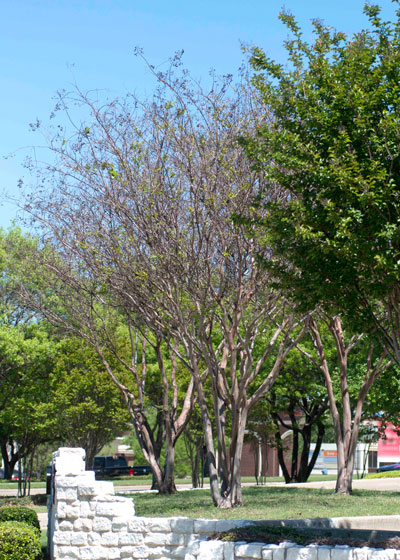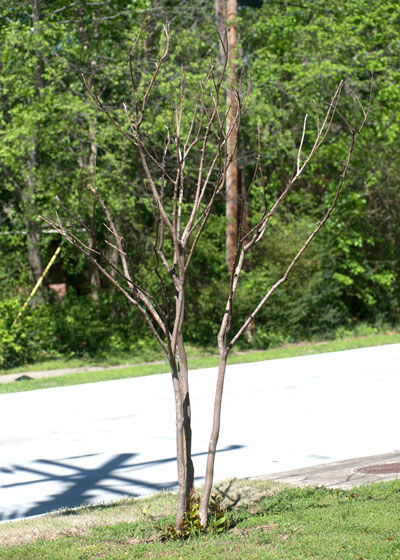Question of the Week 2: April 6, 2017

Photo: This particular crape myrtle variety appears to have suffered freeze damage in January 2017.
“Neil, my crape myrtle doesn’t look like it’s going to put out any leaves. Is it dead? What would have caused that?”
(Question is primarily coming from North Texas.)
The plant isn’t dead, but the top growth apparently is. It froze in that early January really cold weather. However, the root system will still be alive, and you will soon be seeing new shoots pop up around the base of the old trunks.
Those new shoots will be your clue that you have lost the top growth. As soon as you see them, cut the old trunks off as close to the ground as you can. Waiting even a couple of weeks will make that all the more difficult as the new shoots quickly grow taller.
You will probably get 25 or 30 new shoots sprouting up. Leave all of them for a couple of months. Yes, it will look really odd to see a shrubby mass where you had a tree just last fall, but you need to let them grow in size so that you can determine which are the straightest and strongest.

Photo: Young crape myrtle has frozen and is resprouting.
By late spring or early summer you’ll be able to thin them out so that only eight or nine remain. Let them grow the rest of the summer, then thin them down to five or six this fall. You leave extras because they are quite brittle and easily snapped by a mower, pet or errant football or Frisbee.
Next spring, once they have become somewhat woody, they are likely to be 6 or 7 feet tall. At that point you can thin them down to the final number of three or five (odd numbers look best). If you’re concerned that they’re still brittle and could be snapped in a windstorm, put 1×1-inch stakes alongside them for a few months.
Will this all happen to your plant again? Yes, it could if another really bad cold snap plows through. But in the meantime you’ll be pleased with how quickly your plant recovers and looks great again.
Note: This is the very same procedure we recommend for crape myrtles that have been topped in the past, when gardeners want to restore them to their natural growth forms.
As a side comment, when we began The Crape Myrtle Trails of McKinney in 1999 with the intent of planting all known varieties in the same city so we could compare factors such as winter hardiness, we soon found that five full-sized varieties were less durable in North Texas cold. Four are hybrids from the USDA National Arboretum breeding program, and they are Natchez, Tuscarora, Muskogee and Sioux. The fifth is a popular old red type called Country Red.
Each of these has frozen three or more winters in the McKinney plantings during those almost 20 years. For that reason we no longer recommend them for North Texas landscapes. They should be fine in Central and South Texas.
